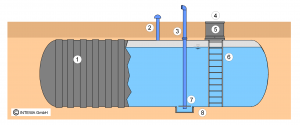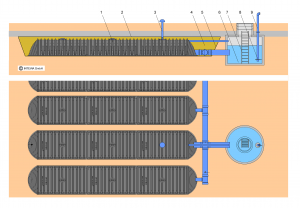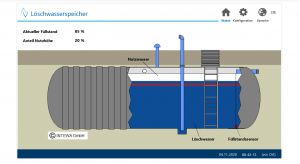Underground Fire Water Systems
One of the most important measures of preventive fire protection is the provision of extinguishing agents in sufficient quantities. Water is the most suitable extinguishing agent for the vast majority of fires. If supply from the drinking water network is possible, this solution is implemented. In many cases, however, an independent supply of fire water is necessary. Underground fire water tanks can be a solution here.
Advantages
for end users
High fire damage, at the same time as there is no reliable supply from the public network: in this case, fire water storage is required.
for municipalities
For new development or expanding construction or commercial properties, a decentralized fire water tank allows for reduced cross-sections of potable water supply.
Basic design
Basic protection
| Building use according to §17 of the Building Use Ordinance | Small settlement (WS) Weekend house areas (SW) | Pure residential areas (WR) General residential areas (WA) Special residential areas (WB) Mixed areas (MI) Village areas (MD) | Core areas (MK) Commercial areas (GE) | Industrial areas (GI) | ||
| Commercial areas (GE) | ||||||
| Number of full storeys | ≤ 2 | ≤ 3 | > 3 | 1 | > 1 | - |
| Number of storeys (GFZ) | ≤ 0,4 | ≤ 0,3 - 0,6 | 0,7 - 1,2 | 0,7 - 1,0 | 1,0 - 2,4 | - |
| Building mass number (BMZ) | - | - | - | - | - | ≤ 9 |
| Fire water requirement for different risks of fire spread: | m³/h | m³/h | m³/h | m³/h | m³/h | m³/h |
| small | 24 | 48 | 96 | 96 | 96 | 96 |
| medium | 48 | 96 | 96 | 192 | 192 | 192 |
| big | 96 | 96 | 192 | 192 | 192 | 192 |
DVGW Guideline W 405 determines the demand for fire water. It is to be applied for the planning and construction of specified development areas and for constructions in outdoor areas.
Property protection
According to DVGW Guideline W 405, property protection is the property-specific fire water supply for buildings with a particular fire risk that goes beyond basic protection. A distinction is made between public and non-public fire water supplies. This classification is particularly important for the building permit procedure, because requirements can only be made for the non-public fire water supply.
Storage capacity
DIN 14230 distinguishes between small (75 m3 to 150 m³), medium (from more than 150 m³ to 300 m³) and large (of more than 300 m³) fire water tanks. The withdrawal piping is defined according to DIN 14244.
Implementation
Variants
The fire water volume can be designed in two structural variants. Either by a single underground fire water tank that can hold the entire volume of fire water or by connecting several individual underground tanks. The sum of the connected individual tanks then results in the total capacity of the fire water tank.
Material
There are no restrictions on the choice of material. The fire water tank must be stable and durable against the forces acting on it.
Shape
The geometry of the fire water tank may be chosen in any way and adapted to the local conditions. The tank must be accessible for inspection and maintenance purposes and 18 tons passable. The fire water tank must be designed in such a way that the entire volume can be inspected and cleaned.
System examples
with GRP underground tank
The tank can be configured very individually and thus according to customer or project requirements. The tank equipment is based on the specifications of DIN 14230 and includes, for instance, the access dome with 1 m diameter and D400 cover, an access ladder, the venting and withdrawal piping with “Storz A”-coupling made of stainless steel incl. anti-vortex plate. The tank can be filled via a rainwater base line or externally via an additional filling nozzle or directly via the manhole. Compared to an identical GRP underground tank, a 100 m³ concrete storage tank has about 25 times the weight.
- GRP tank
- Stainless steel vent piping with cover and insect screen
- Stainless steel withdrawal piping with Storz coupling form A
- Cover D400 galvanized steel
- Manhole
- Access ladder
- Anti-vortex plate
- Pumping sump
https://www.intewa.com/en/fire-water/fire-water-system-solutions/
with filling element storage in foil and suction pit
By laying the system in a foil jacket, almost any system size with a very flat structure can be realized. This saves costs for civil engineering. This special foil is an absolutely waterproof, high-strength, elastic EPDM foil without any connecting seams in one piece. The water withdrawal is done via a suction pit on the side, which is also used for maintenance and inspection. The equipment of the storage chamber and suction pit is based on the specifications of DIN 14230.
- DRAINMAX trench
- Filter fabric
- Ventilation
- Backfilling of tunnel
- Filter fabric
- Suction pit
- Ladder
- Anti-vortex plate
- Suction pipe
https://www.intewa.com/en/fire-water/fire-water-system-solutions/
Digital monitoring and multiple use of the storage volume
Bis dato wird der Füllstand von Löschwasserspeichern wenn überhaupt nur manuell überwacht. Dies stellt ein großes Sicherheitsrisiko für den etwaigen Brandfall dar, falls der vorgesehene Wasserstand durch Undichtigkeit oder sogar eine unzulässige Entnahme für eine andere Anwendung, wie z.B. die Bewässerung, nicht mehr vorhanden wäre. Aus diesem Grund werden bisher Löschwasserspeicher auch nicht für weitere Nutzungsmöglichkeiten mit zusätzlichem Speichervolumen verwendet. Der Einsatz für weitere Nutzungsmöglichkeiten bietet dabei jedoch wesentliche Vorteile. Zum Beispiel eignet sich der Speicher neben der Löschwasserbevorratung ebenfalls ideal für die Trinkwasser- oder Kühlwasser- Notbevorratung. Falls das zusätzliche Volumen mit Regenwasser zur Bewässerung, als Betriebswasser oder Retentionsvolumen verwendet werden soll, muss ein entsprechender Regenwasserfilter sowie ein Überlauf eingeplant werden.
Mit der I-CONNECT Technologie können Löschwassersysteme weltweit fernüberwacht werden. Das System nutzt die Symbiose aus Hardware, der im Erdreich vergrabenen Anlage sowie einer Steuerung, und Software, welche über ein Interface via PC, Tablet oder Smartphone oder auch offline über eine USB-Verbindung übersichtlich dargestellt wird. Anlagenbetreiber sind jetzt in der Lage, ihr System jederzeit zu steuern oder zu monitoren. Zum Beispiel kann der aktuelle Füllstand über die stetige Dokumentation dieser Daten angezeigt oder Alarme bei zu niedrigem Füllstand geschaltet werden.
https://www.intewa.com/de/produkte/i-connect/steuerungen/loeschwasserbevorratung/
Rechtliche Rahmenbedingungen
- DVGW Arbeitsblatt W405 2008 Bereitstellung von Löschwasser durch die öffentliche Trinkwasserversorgung
- DIN 14230:2012 Unterirdische Löschwasserbehälter
- DIN 14244:2003 Löschwasser-Sauganschlüsse - Überflur und Unterflur


